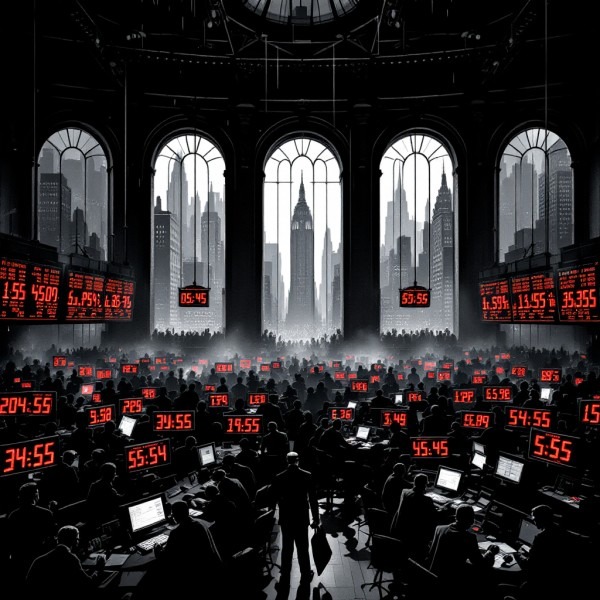What Can the Panic of 1907 Teach Modern Investors?
Dec 25, 2024
Imagine a time when a single man’s actions could determine the fate of the entire financial system. In 1907, that was precisely the case when J.P. Morgan stepped in to save the United States from a catastrophic economic collapse. But what truly triggered the stock market panic of 1907, and what lessons can today’s investors glean from this historical upheaval? Understanding that era’s psychological undercurrents and strategic missteps can illuminate the path to smarter investing in our tumultuous times.
The Spark That Ignited the 1907 Crash
The stock market panic of 1907, also known as the Knickerbocker Crisis, was precipitated by a failed attempt to corner the market on United Copper Company shares. Spearheaded by speculators Augustus Heinze and Charles Morse, the scheme quickly unravelled, leading to a loss of confidence in financial institutions associated with them. The panic spread as depositors rushed to withdraw funds, causing a liquidity crisis among New York City banks and trusts.
At the heart of the panic was the public’s fear and uncertainty. The rapid dissemination of rumours exacerbated the situation, highlighting how emotions can override rational decision-making in financial markets. The collapse wasn’t solely due to failed speculation but was magnified by the herd mentality that gripped investors and depositors alike.
Mass psychology was pivotal in turning a financial blunder into a full-blown crisis. As news of the failed cornering scheme spread, panic became contagious. People tend to follow the crowd, especially in times of uncertainty—a phenomenon known as herd behaviour. When individuals see others rushing to withdraw their money, they feel compelled to do the same, fearing they might be left behind in the event of a bank failure.
Behavioral finance experts suggest that such reactions are deeply rooted in human psychology. Fear can trigger a fight-or-flight response, leading to irrational decisions that may not align with an individual’s long-term financial interests. The 1907 panic is a classic example of how collective emotions can disrupt markets and create self-fulfilling prophecies of doom.
J.P. Morgan’s Intervention: A Lesson in Strategic Action
As the crisis worsened, J.P. Morgan orchestrated a plan to stabilize the financial system. He convinced other bankers to provide liquidity to struggling institutions, effectively acting as a lender of last resort. Morgan’s decisive action helped to restore confidence, illustrating the power of strategic intervention during market turmoil.
For modern investors, this episode underscores the importance of taking calculated actions rather than succumbing to panic. While most individuals don’t influence J.P. Morgan, they can control their reactions to market fluctuations. Instead of selling off assets during a downturn, strategic buying can position investors for significant gains when the market recovers.
The Dangers of Herd Mentality: Comparisons to Recent Crises
The panic of 1907 isn’t an isolated case; history is replete with examples where herd mentality led to market bubbles and crashes. For instance, the housing bubble of 2008 was fueled by speculative buying and the widespread belief that real estate prices would continue to rise indefinitely. When the bubble burst, panic selling ensued, leading to a global financial crisis.
Similarly, the dot-com crash of the early 2000s saw investors pouring money into internet startups without solid business models, driven by the fear of missing out on the next big thing. When reality set in, massive sell-offs occurred, and many lost significant portions of their investments.
These examples highlight the recurring pattern of irrational exuberance followed by fear-driven sell-offs. Investors who recognize these patterns and resist the urge to follow the crowd can avoid significant losses and even capitalize on market downturns.
Technical Analysis: Reading the Signs Before the Storm
Technical analysis involves studying statistical trends from trading activity, such as price movement and volume. Before the 1907 panic, certain indicators could have signalled potential trouble. Savvy investors might have noticed that overvalued stock prices, unusually high trading volumes, and excessive speculation were red flags.
Investors can identify market trends and potential reversal points by incorporating technical analysis. This approach allows individuals to make informed decisions based on data rather than emotions. While technical analysis isn’t foolproof, it can be valuable in anticipating market movements and mitigating risks.
Contrarian investors go against prevailing market trends by buying when others are selling and selling when others are buying. This strategy requires a firm understanding of market fundamentals and a willingness to act independently of the crowd. During the panic of 1907, those who recognized the overreaction could acquire valuable assets at depressed prices.
Renowned investor Warren Buffett encapsulates this philosophy with his advice: “Be fearful when others are greedy and greedy when others are fearful.” By adopting a contrarian mindset, investors can exploit market inefficiencies created by emotional reactions, positioning themselves for long-term success.
Emotional Cycles and Market Timing
Financial markets often move in cycles influenced by collective emotions. The phases typically progress from optimism to excitement, euphoria, anxiety, denial, fear, and despair. Recognizing these emotional stages can help investors make timely decisions that align with their financial goals.
Timing is crucial in investing. Securing profits during euphoric peaks can protect gains before a downturn erases them. Conversely, strategic buying during widespread fear can set the stage for substantial future returns. This approach requires discipline and the ability to remain objective amidst market hype or panic.
Applying Lessons from 1907 to Today’s Markets
The stock market panic of 1907 offers timeless lessons for modern investors. Understanding the psychological drivers behind market movements can lead to more informed and strategic investment choices. Investors can avoid common pitfalls by recognizing the signs of herd mentality and emotional extremes.
In today’s fast-paced markets, information spreads instantaneously. Social media and 24-hour news cycles can amplify emotions, making it even more challenging to stay grounded. However, the fundamental principles of sound investing remain the same. Focus on long-term objectives, conduct thorough research, and resist the urge to make impulsive decisions based on fear or greed.
Knowledge is a powerful tool in navigating financial markets. Educating oneself about historical market events, psychological biases, and analytical techniques can build confidence. A well-thought-out investment strategy that accounts for one’s risk tolerance and financial goals can serve as a roadmap during turbulent times.
Moreover, consulting with financial professionals and learning from experienced investors can provide additional perspectives. Engaging with a community that values rational analysis over emotional reactions can reinforce disciplined investing habits.
Conclusion: Navigating Market Swings with Clarity and Purpose
The panic of 1907 stands as a testament to the impact of human psychology on financial markets. By examining the triggers and reactions of that era, modern investors can gain valuable insights into managing their portfolios more effectively. Strategies such as embracing contrarian thinking, applying technical analysis, and understanding emotional cycles can enhance investment outcomes.
Ultimately, the key to navigating market swings lies in maintaining clarity of purpose and resisting the pull of collective emotions. By focusing on long-term objectives and making informed decisions, investors can turn market volatility into opportunities for growth. The lessons of the past serve not only as cautionary tales but also as guides to better, more confident investing in the future.











